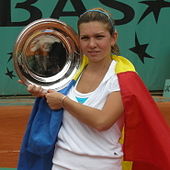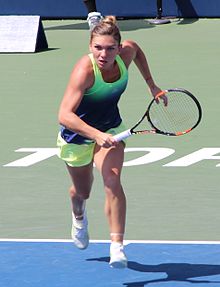Simona Halep
Halep was regarded as one of the best returners on the WTA Tour, building her game around controlled aggression and being able to hit winners from defensive positions.
[6] Halep's father played lower-division football for AS Săgeata Stejaru and worked as a zootechnics technician before becoming the owner of a dairy products factory.
The following year, Halep won all four ITF singles events she entered, including the Mamaia-Sen tournament which was reclassified to mid-level Grade 3.
After focusing on professional tournaments, Halep returned to the junior circuit in May and won her first Grade A title at the Trofeo Bonfiglio without dropping a set.
As the ninth seed, she defeated the fifth-seed Moore and the second-seed Rus en route to reaching the final without losing a set.
Halep defeated compatriot Elena Bogdan in three sets in the final to become the second Romanian girl to win a junior Grand Slam singles title after Mariana Simionescu won the 1974 French Open.
[21] During the clay court season, Halep defended her runner-up finish at the Morocco Open from the previous year, again losing in the final, this time to Alberta Brianti.
Although Halep defeated top seed Anabel Medina Garrigues in Morocco, she was upset by qualifier Kiki Bertens, who prevented her from reaching a third straight final at the event.
[42] Halep attributed her improvement to developing a more positive mindset, saying, "What changed was that I allowed myself to be relaxed on the court by taking the pressure off.
[15] During the clay-court season, Halep won her second career Premier Mandatory title, defeating Dominika Cibulková in the final of the Madrid Open to return to the top 5.
[82] She also made her first career WTA doubles final at the Canadian Open, finishing runner-up to Ekaterina Makarova and Elena Vesnina alongside compatriot Monica Niculescu.
Halep and Davis tied the Australian Open record for most games played in the women's singles main draw match with 48.
[129] She received a difficult draw at the Australian Open and lost in the fourth round to Serena Williams, who had finished runner-up at the previous two Grand Slam events.
Nonetheless, she won the championship easily in under an hour, losing just two games in each set, and committing only three unforced errors in the entire match, the fewest ever recorded in a Grand Slam final.
[145] At the Australian Open, Halep reached the semifinals, where she lost to Garbiñe Muguruza,[146] after having defeated Jennifer Brady,[147] Harriet Dart,[148] Yulia Putintseva,[149] Elise Mertens,[150] and Anett Kontaveit.
[157] In April, at the Porsche Tennis Grand Prix, she defeated Markéta Vondroušová and Ekaterina Alexandrova, but lost to Aryna Sabalenka in the semifinals.
[173] Halep reached further semifinals at Birmingham Classic, where she lost in three sets to Haddad Maia, and in June at the Bad Homburg Open, where she was forced to withdraw before the match due to a neck injury.
[174][175] At Wimbledon, Halep reached the semifinals without dropping a set, beating Karolína Muchová, Kirsten Flipkens, Magdalena Fręch, No.
[187][188] The International Tennis Integrity Authority (ITIA) published a 126-page detailed report on its investigation of the doping violations and the inconsistencies in her biological passport.
[198] Halep's next WTA Tour match was on 28 October at the Hong Kong Tennis Open, where she was given a wildcard entry but lost in the first round to Yuan Yue.
[214] They then won a playoff against Ukraine, with Halep and Sorana Cîrstea winning the two singles rubbers, to advance to the World Group II play-offs.
[218] Halep postponed having nose surgery to make her Fed Cup World Group debut in the first round against the defending champion Czech Republic team at home in Cluj.
[226] Like their last appearance in the World Group three years earlier, they were drawn against the defending champion Czech Republic team, who hosted the tie unlike in 2016.
In the decisive doubles rubber, Begu and Niculescu defeated Siniaková and Barbora Krejčíková to win the tie and put Romania in the semifinals.
Journalist Louisa Thomas has compared her improved style of play to that of Novak Djokovic as someone who can hit strong but simple winners from defensive positions where opponents would expect a less aggressive shot.
After a 4th round loss at the 2022 Australian Open and inconsistent results in the Middle Eastern swing, Halep hired Patrick Mouratoglou to her team in May 2022.
[5] After Halep won Grand Slam titles at the 2018 French Open and 2019 Wimbledon, she was welcomed back to Romania with large celebrations at the Arena Națională in Bucharest.
Romanian International Tennis Hall of Fame and businessman Ion Țiriac presided over the Wimbledon celebration, which was attended by several of the most notable athletes in the country's history including footballer Gheorghe Hagi and Olympic gold medal gymnast Nadia Comăneci.
[42] Halep underwent breast reduction surgery at the age of 17 primarily to improve "her ability to react quickly" as a tennis player.
[185] Chris Evert (1975/1985 – 260 w) Evonne Goolagong (1976 – 2 w) Martina Navratilova (1978/1987 – 331 w) Tracy Austin (1980 – 22 w) Steffi Graf (1987/1997 – 377 w) // Monica Seles (1991/1996 – 178 w) Arantxa Sánchez Vicario (1995 – 12 w) Martina Hingis (1997/2001 – 209 w) Lindsay Davenport (1998/2006 – 98 w) Jennifer Capriati (2001/2002 – 17 w) Venus Williams (2002 – 11 w) Serena Williams (2002/2017 – 319 w) Kim Clijsters (2003/2011 – 20 w) Justine Henin (2003/2008 – 117 w) Amélie Mauresmo (2004/2006 – 39 w) Maria Sharapova (2005/2012 – 21 w) Ana Ivanovic (2008 – 12 w) Jelena Janković (2008/2009 – 18 w) Dinara Safina (2009 – 26 w) Caroline Wozniacki (2010/2018 – 71 w) Victoria Azarenka (2012/2013 – 51 w) Angelique Kerber (2016/2017 – 34 w) Karolína Plíšková (2017 – 8 w) Garbiñe Muguruza (2017 – 4 w) Simona Halep (2017/2019 – 64 w) Naomi Osaka (2019 – 25 w) Ashleigh Barty (2019/2022 – 121 w) Iga Świątek (2022/2024 – 125 w) Aryna Sabalenka (2023/2024 – 9 w)









